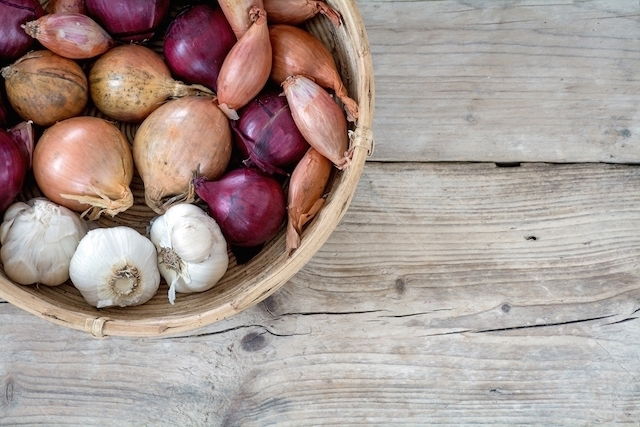Garlic is a part of a bulb plant and is commonly used in the kitchen to season and condiment foods. It can also be used as a natural remedy to complement the treatment of many health conditions, like fungal infections or high blood pressure.
This food is rich in sulfuric compounds, especially allicin, which gives garlic its characteristic odor. These compounds are responsible for garlic’s functional properties.
Garlic is also rich in various minerals that nourish the body, like potassium, calcium and magnesium.

Health benefits
The primary benefits of garlic include:
1. Fighting viral, fungal and bacterial infections
Garlic contains sulfuric compounds, known as allicin, which provides it with antimicrobial action. It inhibits the growth and development of bacteria, viruses and fungi. It also helps to eliminate harmful toxins and bacteria that infect intestinal flora, making it very useful to complement the treatment for worm infections.
2. Preventing colon cancer
Allicin and alliin, the sulfuric compounds found in garlic, have a potent antioxidant action that prevent the formation of free radicals and protect cells from damage. These compounds also stimulate certain enzymes to detox the body from agents that can cause colon cancer.
3. Protecting heart health
Garlic helps to reduce LDL cholesterol and triglyceride levels by inhibiting the oxidation of these substances. As a result, garlic can reduce the risk for atherosclerosis, which can lead to several cardiovascular diseases.
Garlic can also help to regulate blood pressure, as it has a mild antihypertensive effect. It can also improve blood circulation, which reduces pressure within the blood vessels, and also prevents the formation of clots by inhibiting excess platelet aggregation.
4. Improving inflammatory diseases
The sulfuric compounds of garlic contain anti-inflammatory action that reduce the body’s response to some illnesses that cause chronic inflammation. As such. garlic can also be used to complement the treatment of some inflammatory diseases to reduce pain and regulate immune system responses.
5. Preventing respiratory disease
Garlic can help to stimulate respiratory functions thanks to is expectorant and antiseptic functions. Therefore, garlic can be used to treat colds, flus, snoring, asthma. bronchitis and other pulmonary issues.
6. Maintaining brain health
Garlic contains allicin and sulfur, which have antioxidant and anti-inflammatory action, as well as sellenium and choline. For this reason, garlic can help to protect brain cells and protect them from free radical damage. This damage is associated with neurodegenerative diseases, like Alzheimer’s and dementia.
Therefore, garlic has great potential for improving memory, promoting learning and improving brain health.
7. Helping to manage diabetes
Some studies show that garlic has antidiabetic properties and that it can increase insulin secretion from beta-cells in the pancreas. This can help to improve pancreatic function and prevent and control diabetes.
How to use garlic
To obtain its benefits, you should consume 1 clove of fresh garlic per day. One way to boost its properties is by chopping or smashing the garlic and letting it rest for 10 minutes before using. This increases the quantity of allicin in garlic, which is the main medicinal property in this food.
Garlic can be used to season meat, salads, sauces and pasta. It can also be prepared as a tea or water, which can reduce cholesterol and protect the heart if consumed regularly. Check out other tips for lowering cholesterol.
Nutritional informational
The following table outlines the nutritional content in 100 g of fresh garlic:
One garlic clove per day can help to achieve the above-listed health benefits, although using garlic for as a complement to the treatment for specific conditions should be monitored by a doctor or medicinal plant specialist.
How to purchase and store
When purchasing garlic, you should look for round, well-shaped garlic heads without any marks. The cloves should be firm and well-merged.
To prevent molding, garlic should be stored in a fresh, dry, and mildly ventilated area.
Side effects and contraindications
Excess intake of garlic can lead to digestive problems, cramping, gas, vomiting, diarrhea, headache, kidney pain and dizziness.
Raw garlic as a natural remedy is contraindicated for newborns and should be avoided by patients healing from surgery. It is not advised for patients with a history of low blood pressure, stomach pain, hemorrhages and clotting diseases, nor for people who take anti-clotting medication.
Garlic is also not recommended for pregnant or breastfeeding women. It should especially not be consumed in high concentrations or as a supplement by these populations, as it can cause a miscarriage and even affect the menstrual cycle. Some studies show that consuming garlic during breastfeeding can alter the milk’s odor.
Garlic recipes
Some ways to consume garlic and obtain all of its benefits are:
1. Garlic tea
Garlic tea can be prepared with one garlic clove for every 100 to 200 mL of water. Place a chopped and smashed clove in boiling water and soak for 5 to 10 minutes. Then remove from heat, strain and allow to cool.
To improve its taste, you can add grated ginger, a few drops of lemon juice or a teaspoon of honey.
2. Garlic water
To prepare garlic water, place one garlic clove in 100 mL of water and allow to soak the whole night, or at least 8 hours. This water can be consumed while fasting to detox the gut and reduce cholesterol.
3. Garlic cream for meat
Ingredients
- 1 cup of milk
- 3 cloves of garlic
- 1 pinch of salt, parsley and oregano
- Olive oil
How to prepare
Mix the milk, garlic, salt, parsley and oregano in a blender until well-combined. Then add the olive oil slowly until a cream has formed. You can use this cream to season barbeque meat or to make garlic bread.
